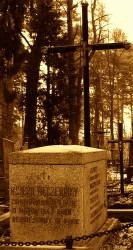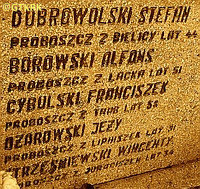Roman Catholic
St Sigismund parish
05-507 Słomczyn
85 Wiślana Str.
Konstancin deanery
Warsaw archdiocese, Poland
full list:
displayClick to display full list

searchClick to search full list by categories
wyświetlKliknij by wyświetlić pełną listę po polsku

szukajKliknij by przeszukać listę wg kategorii po polsku

Martyrology of the clergy — Poland
XX century (1914 – 1989)
personal data

surname
DOBROWOLSKI
forename(s)
Steven (pl. Stefan)
function
diocesan priest
creed
Latin (Roman Catholic) Church RCmore on
en.wikipedia.org
[access: 2014.09.21]
diocese / province
Vilnius archdiocesemore on
en.wikipedia.org
[access: 2013.05.19]
date and place
of death
10.03.1943

Lidatoday: Lida dist., Grodno reg., Belarus
more on
en.wikipedia.org
[access: 2021.09.29]
details of death
After German and Russian invasion of Poland in 09.1939 and start of the World War II, after German attack in 06.1941 of their erstwhile ally, Russians, arrested by Germans in 06/07.1942 during mass arrests of Polish intelligentsia from Lida region — known as «Polenaktion» — together with 16 other priests.
Jailed in Lida prison.
On c. 22.12.1942 together with Fr Joseph Bujar and Fr Lucien Mroczkowski moved to a prison hospital.
On 02.02.1943 brought back to the prison cell.
After 9 months incarceration murdered together with 8 other priests, in a forest by the shooting range of German military barracks in Lida.
cause of death
mass murder
perpetrators
Germans
sites and events
Lida (massacre)Click to display the description, «Polenaktion» 1942Click to display the description, Ribbentrop‐MolotovClick to display the description, Pius XI's encyclicalsClick to display the description
date and place
of birth
14.11.1899

Novosyadytoday: Byenyakoni ssov., Voranava dist., Grodno reg., Belarus
more on
be.wikipedia.org
[access: 2023.01.18]
parents
DOBROWOLSKI Anthony
🞲 ?, ? — 🕆 ?, ?

BUSŁOWICZ Eve
🞲 ?, ? — 🕆 ?, ?
presbyter (holy orders)
ordination
24.04.1927

Vilniustoday: Vilnius city dist., Vilnius Cou., Lithuania
more on
en.wikipedia.org
[access: 2022.01.06]
St Stanislav the Bishop and Martyr and St Vladislav RC cathedral churchmore on
en.wikipedia.org
[access: 2025.03.14]
positions held
1937 – 1942
parish priest — Belitsatoday: Belitsa ssov., Lida dist., Grodno reg., Belarus
more on
be.wikipedia.org
[access: 2023.01.18] ⋄ St George the Martyr RC parish ⋄ Lidatoday: Lida dist., Grodno reg., Belarus
more on
en.wikipedia.org
[access: 2021.09.29] RC deanery
1933 – 1937
parish priest — Dzisna Konstantinovotoday: Konstantinovo, Karaby ssov., Hlybokaye dist., Vitebsk reg., Belarus
more on
be.wikipedia.org
[access: 2023.01.18] ⋄ Holy Trinity RC parish ⋄ Hlybokayetoday: Hlybokaye dist., Vitebsk reg., Belarus
more on
en.wikipedia.org
[access: 2021.10.09] RC deanery
1931 – 1933
prefect — Vilniustoday: Vilnius city dist., Vilnius Cou., Lithuania
more on
en.wikipedia.org
[access: 2022.01.06] ⋄ primary schools ⋄ St Therese the Virgin RC parish (Gate of Dawn) ⋄ Vilniustoday: Vilnius city dist., Vilnius Cou., Lithuania
more on
en.wikipedia.org
[access: 2022.01.06] RC deanery
c. 1929 – 1931
prefect — Rakawtoday: Rakaw ssov., Valozhyn dist., Minsk reg., Belarus
more on
en.wikipedia.org
[access: 2020.12.11] ⋄ primary schools ⋄ Our Lady of the Rosary RC parish ⋄ Vileykatoday: Vileyka dist., Minsk reg., Belarus
more on
en.wikipedia.org
[access: 2022.01.06] RC deanery
1927 – c. 1928
vicar — Rakawtoday: Rakaw ssov., Valozhyn dist., Minsk reg., Belarus
more on
en.wikipedia.org
[access: 2020.12.11] ⋄ Our Lady of the Rosary RC parish ⋄ Vileykatoday: Vileyka dist., Minsk reg., Belarus
more on
en.wikipedia.org
[access: 2022.01.06] RC deanery — also: prefect of elementary schools
1927
vicar — Parafyanavatoday: Parafyanava ssov., Dokshytsy dist., Vitebsk reg., Belarus
more on
be.wikipedia.org
[access: 2023.01.18] ⋄ Name of the Blessed Virgin Mary RC parish ⋄ On‐the‐Vilniadeanery name
today: Belarus RC deanery
1919 – 1927
student — Vilniustoday: Vilnius city dist., Vilnius Cou., Lithuania
more on
en.wikipedia.org
[access: 2022.01.06] ⋄ philosophy and theology, Theological Seminary
others related
in death
AUGUSTYNOWICZClick to display biography Alexander, BOBICZClick to display biography Ildephonsus, BOROWSKIClick to display biography Alphonse, BUJARClick to display biography Joseph, CYBULSKIClick to display biography Francis, ŁABANClick to display biography Vincent, MROCZKOWSKIClick to display biography Lucian, OŻAROWSKIClick to display biography George, STRZEŚNIEWSKIClick to display biography Vincent, ŚNIEGOCKIClick to display biography Steven
sites and events
descriptions
Lida (massacre): In 06‐07.1942 arrested c. 100 Poles in Lida and vicinity, including c. 16 Polish catholic priests. All were jailed in Lida prison. Some were subseqently released, others perished in prison. On 10.03.1943 in a nearby pine forest, by infantry barracks, Germans murdered remaining 9 priests and 5 other Poles. (more on: www.archibial.plClick to attempt to display webpage
[access: 2013.12.04], ipn.gov.plClick to attempt to display webpage
[access: 2013.12.04])
«Polenaktion» 1942: In the summer of 1942 in German‐occupied Germ. Generalbezirk Weißruthenien (Eng. General Region of Belarus) — in Nowogródek region among others — Germans carried out «Polenaktion» initiative: the name introduced in a special resolution drafted by Reichssicherheitshauptamt RSHA (Eng. Reich Main Security Office). The action included sacking of all Poles from civilian regional apparatus and police and replacing them with Belarusians. Thousands of Poles were also forcibly deported to Germany as slave labourers. On 26‐30.06.1942 in all counties of the region more than 1,000 representatives of Polish intelligentsia were arrested and subsequently murdered. In Lida region 16 Polish priests were arrested among others. 5 Polish parish priests from Hlybokaye and Pastavy deanery were murdered as well. At the same time Germans set up KL Koldichevo concentration camp n. Baranavichy. The implementation of this genocide project was entrusted to Belarusian collaborationist formations, political, administrative — responsible for preparation of proscription lists — and police, i.e. niem. Weißruthenische Hilfspolizei (Eng. Belarusian Auxiliary Police), supported by Ukrainian, Lithuanian, Latvian and Russian (RONA) collaborators. The action was coordinated with the liquidation of the Jewish ghettos in the Germ. Generalbezirk Weißruthenien.
Ribbentrop‐Molotov: Genocidal Russian‐German alliance pact between Russian leader Joseph Stalin and German leader Adolf Hitler signed on 23.08.1939 in Moscow by respective foreign ministers, Mr. Vyacheslav Molotov for Russia and Joachim von Ribbentrop for Germany. The pact sanctioned and was the direct cause of joint Russian and German invasion of Poland and the outbreak of the World War II in 09.1939. In a political sense, the pact was an attempt to restore the status quo ante before 1914, with one exception, namely the „commercial” exchange of the so‐called „Kingdom of Poland”, which in 1914 was part of the Russian Empire, fore Eastern Galicia (today's western Ukraine), in 1914 belonging to the Austro‐Hungarian Empire. Galicia, including Lviv, was to be taken over by the Russians, the „Kingdom of Poland” — under the name of the General Governorate — Germany. The resultant „war was one of the greatest calamities and dramas of humanity in history, for two atheistic and anti‐Christian ideologies — national and international socialism — rejected God and His fifth Decalogue commandment: Thou shall not kill!” (Abp Stanislav Gądecki, 01.09.2019). The decisions taken — backed up by the betrayal of the formal allies of Poland, France and Germany, which on 12.09.1939, at a joint conference in Abbeville, decided not to provide aid to attacked Poland and not to take military action against Germany (a clear breach of treaty obligations with Poland) — were on 28.09.1939 slightly altered and made more precise when a treaty on „German‐Russian boundaries and friendship” was agreed by the same murderous signatories. One of its findings was establishment of spheres of influence in Central and Eastern Europe and in consequence IV partition of Poland. In one of its secret annexes agreed, that: „the Signatories will not tolerate on its respective territories any Polish propaganda that affects the territory of the other Side. On their respective territories they will suppress all such propaganda and inform each other of the measures taken to accomplish it”. The agreements resulted in a series of meeting between two genocidal organization representing both sides — German Gestapo and Russian NKVD when coordination of efforts to exterminate Polish intelligentsia and Polish leading classes (in Germany called «Intelligenzaktion», in Russia took the form of Katyń massacres) where discussed. Resulted in deaths of hundreds of thousands of Polish intelligentsia, including thousands of priests presented here, and tens of millions of ordinary people,. The results of this Russian‐German pact lasted till 1989 and are still in evidence even today. (more on: en.wikipedia.orgClick to attempt to display webpage
[access: 2015.09.30])
Pius XI's encyclicals: Facing the creation of two totalitarian systems in Europe, which seemed to compete with each other, though there were more similarities than contradictions between them, Pope Pius XI issued in 03.1937 (within 5 days) two encyclicals. In the „Mit brennender Sorge” (Eng. „With Burning Concern”) published on 14.03.1938, condemned the national socialism prevailing in Germany. The Pope wrote: „Whoever, following the old Germanic‐pre‐Christian beliefs, puts various impersonal fate in the place of a personal God, denies the wisdom of God and Providence […], whoever exalts earthly values: race or nation, or state, or state system, representatives of state power or other fundamental values of human society, […] and makes them the highest standard of all values, including religious ones, and idolizes them, this one […] is far from true faith in God and from a worldview corresponding to such faith”. On 19.03.1937, published „Divini Redemptoris” (Eng. „Divine Redeemer”), in which criticized Russian communism, dialectical materialism and the class struggle theory. The Pope wrote: „Communism deprives man of freedom, and therefore the spiritual basis of all life norms. It deprives the human person of all his dignity and any moral support with which he could resist the onslaught of blind passions […] This is the new gospel that Bolshevik and godless communism preaches as a message of salvation and redemption of humanity”… Pius XI demanded that the established human law be subjected to the natural law of God , recommended the implementation of the ideal of a Christian state and society, and called on Catholics to resist. Two years later, National Socialist Germany and Communist Russia came together and started World War II. (more on: www.vatican.vaClick to attempt to display webpage
[access: 2023.05.28], www.vatican.vaClick to attempt to display webpage
[access: 2023.05.28])
sources
personal:
www.bialystok.opoka.org.plClick to attempt to display webpage
[access: 2012.11.23], www.iwieniec.euClick to attempt to display webpage
[access: 2012.12.28], pawet.netClick to attempt to display webpage
[access: 2012.11.23], grodno.msz.gov.plClick to attempt to display webpage
[access: 2014.05.09]
bibliographical:
„Vilnius archdiocese clergy martyrology 1939‐1945”, Fr Thaddeus Krahel, Białystok, 2017
original images:
www.flickr.comClick to attempt to display webpage
[access: 2014.05.09], polska360.orgClick to attempt to display webpage
[access: 2022.01.06], www.ciekawepodlasie.plClick to attempt to display webpage
[access: 2020.07.31]
LETTER to CUSTODIAN/ADMINISTRATOR
If you have an Email client on your communicator/computer — such as Mozilla Thunderbird, Windows Mail or Microsoft Outlook, described at WikipediaPatrz:
en.wikipedia.org, among others — try the link below, please:
LETTER to CUSTODIAN/ADMINISTRATORClick and try to call your own Email client
If however you do not run such a client or the above link is not active please send an email to the Custodian/Administrator using your account — in your customary email/correspondence engine — at the following address:

giving the following as the subject:
MARTYROLOGY: DOBROWOLSKI Steven
To return to the biography press below:
 Click to return to biography
Click to return to biography










